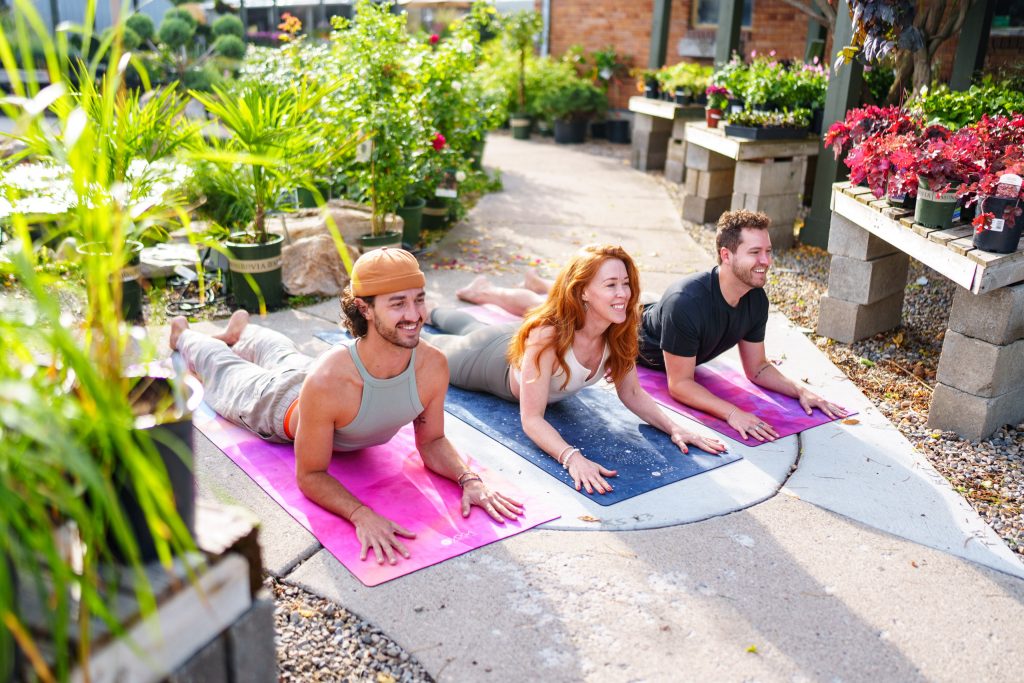Sphinx Pose: Ardha Bhujangasana
Snakes get a bad rap. True, the bites of the venomous varieties can wreak deadly havoc. But most snakes are not poisonous. Some are even beneficial, especially in our yards and gardens. As predators, snakes help control the populations of the hungry pests that consume our fruits and veggies. Today, we’ll explore the benefits of Ardha Bhujangasana (Half Cobra Pose or Sphinx Pose).
One might think that naming Half Cobra Pose “Sphinx Pose” could be a way of avoiding the scary connotations. But I think it has more to do with the arm position that mimics the Great Sphinx of Giza. In fact, in India, cobras are not symbols of evil. Instead, they are celebrated each summer in a festival called Nag Pachami. There, thousands of cobras are gathered and brought to the temple of Shiva to be fed milk and regaled with flowers. Humans spend a day snake dancing in the streets that are lined with snake charmers. When the festivities end the cobras are released unharmed back into their habitat.
Benefits of Cobra and Sphinx Pose
Cobra Pose (Bhujangasana) and its cousin, Sphinx Pose, are two variations of the same pose. As such, their benefits are similar. For practitioners with back issues such as scoliosis, herniated disc or other back injuries, however, full Cobra is contraindicated. In these cases, moving slowly and mindfully into Sphinx Pose can allow a practitioner to reap the benefits of Cobra, without the risks.
Bhujangasana looks like a cobra raised to strike—or to dance. When cobras dance, they raise one third of their body length, while the other two thirds stay grounded. It’s that grounding of the majority of the lower body that allows the upper body to rise toward the sky. The same is true for humans practicing Cobra Pose. It is the grounding of the lower body that creates the lightness in the upper body.
In the case of Sphinx Pose, more than two thirds of the body remain on the ground. This creates even greater stability, and much less curvature in the lumbar spine.
Practiced with care, Sphinx can strengthen the spine, stabilize the sacroiliac joint, stimulate the vital organs, strengthen the glutes and simultaneously energize and calm the nervous system. Practiced with aggression, it can also bite, contributing to back strain and wear and tear in the hip joints.
How to Practice Sphinx Pose
Gather your props: Yoga Mat, folded Yoga Blanket (optional). A Yoga Blanket can be helpful if your anterior superior iliac spine (hip bones) are uncomfortable on the floor.
Spread your mat out on the floor. If you choose to use a folded blanket, place it across the center of your mat.
Lie face down on your mat. If you’re using a blanket, place your pelvis fully on the blanket.
Ground your pelvis and legs.
Lift the upper body only as high as you can without using your arms. Then place your forearms on the ground so your torso stays at the same height. For now, don’t push up with your forearms. This means that your forearms may be placed well in front of your shoulders.
Notice what you feel: are your glutes working here? Can you breathe easily?
Take a 5 to 10 deep, relaxed breaths. Then release back down to a prone position, resting your forehead in your hands.
If you want to explore moving more deeply into the pose, ground your hips and legs again.
This time, lift your upper body again, but place your elbows under your shoulders so that you’re lifting a bit higher. Take care not to disengage the work on the legs and glutes. Continue actively grounding the lower body. (Sometimes when we start to add the support of the arms, we tend to disengage the lower body. This negates the strengthening benefits of Sphinx Pose.
Take 5 to 10 deep, relaxed breaths. Then release back down to a prone position, resting your forehead in your hands.
Leave a Reply Cancel reply
Recent Comments
Archives
- December 2025
- November 2025
- October 2025
- September 2025
- August 2025
- July 2025
- June 2025
- May 2025
- April 2025
- March 2025
- February 2025
- January 2025
- December 2024
- November 2024
- October 2024
- September 2024
- August 2024
- July 2024
- June 2024
- May 2024
- April 2024
- March 2024
- February 2024
- January 2024
- December 2023
- November 2023
- October 2023
- September 2023
- August 2023
- July 2023
- May 2023
- March 2023
- August 2022
- July 2022
- June 2022
- May 2022
- April 2022
- March 2022
- February 2022
- January 2022
- December 2021
- November 2021
- October 2021
- September 2021
- August 2021
- July 2021
- June 2021
- May 2021
- April 2021
- March 2021
- February 2020
- January 2020
Theme by The WP Club . Proudly powered by WordPress
